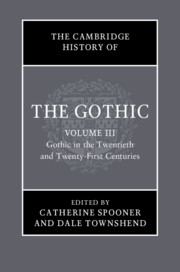Book contents
- The Cambridge History of the Gothic
- The Cambridge History of the Gothic
- The Cambridge History of the Gothic
- Copyright page
- Contents
- Figures
- Notes on Contributors
- Acknowledgements
- Introduction: A History of Gothic Studies in the Twentieth and Twenty-First Centuries
- 3.1 Gothic and Silent Cinema
- 3.2 Gothic, the Great War and the Rise of Modernism, 1910‒1936
- 3.3 Gothic and the American South, 1919‒1962
- 3.4 Hollywood Gothic, 1930–1960
- 3.5 Gothic and War, 1930‒1991
- 3.6 Gothic and the Postcolonial Moment
- 3.7 Gothic and the Heritage Movement in the Twentieth and Twenty-First Centuries
- 3.8 Gothic Enchantment: The Magical Strain in Twentieth and Twenty-First-Century Anglo-American Gothic
- 3.9 Psychoanalysis and the American Popular Gothic, 1954–1980
- 3.10 Gothic and the Counterculture, 1958‒Present
- 3.11 Gothic Television
- 3.12 Gothic and the Rise of Feminism
- 3.13 Gothic, AIDS and Sexuality, 1981–Present
- 3.14 The Gothic in the Age of Neo-Liberalism, 1990‒Present
- 3.15 The Gothic and Remix Culture
- 3.16 Postdigital Gothic
- 3.17 Gothic Multiculturalism
- 3.18 Gothic, Neo-Imperialism and the War on Terror
- 3.19 Global Gothic 1: Islamic Gothic
- 3.20 Global Gothic 2: East Asian Gothic
- 3.21 Global Gothic 3: Gothic in Modern Scandinavia
- 3.22 Gothic in an Age of Environmental Crisis
- 3.23 Gothic and the Apocalyptic Imagination
- Select Bibliography and Filmography
- Index
Introduction: A History of Gothic Studies in the Twentieth and Twenty-First Centuries
Published online by Cambridge University Press: 29 July 2021
- The Cambridge History of the Gothic
- The Cambridge History of the Gothic
- The Cambridge History of the Gothic
- Copyright page
- Contents
- Figures
- Notes on Contributors
- Acknowledgements
- Introduction: A History of Gothic Studies in the Twentieth and Twenty-First Centuries
- 3.1 Gothic and Silent Cinema
- 3.2 Gothic, the Great War and the Rise of Modernism, 1910‒1936
- 3.3 Gothic and the American South, 1919‒1962
- 3.4 Hollywood Gothic, 1930–1960
- 3.5 Gothic and War, 1930‒1991
- 3.6 Gothic and the Postcolonial Moment
- 3.7 Gothic and the Heritage Movement in the Twentieth and Twenty-First Centuries
- 3.8 Gothic Enchantment: The Magical Strain in Twentieth and Twenty-First-Century Anglo-American Gothic
- 3.9 Psychoanalysis and the American Popular Gothic, 1954–1980
- 3.10 Gothic and the Counterculture, 1958‒Present
- 3.11 Gothic Television
- 3.12 Gothic and the Rise of Feminism
- 3.13 Gothic, AIDS and Sexuality, 1981–Present
- 3.14 The Gothic in the Age of Neo-Liberalism, 1990‒Present
- 3.15 The Gothic and Remix Culture
- 3.16 Postdigital Gothic
- 3.17 Gothic Multiculturalism
- 3.18 Gothic, Neo-Imperialism and the War on Terror
- 3.19 Global Gothic 1: Islamic Gothic
- 3.20 Global Gothic 2: East Asian Gothic
- 3.21 Global Gothic 3: Gothic in Modern Scandinavia
- 3.22 Gothic in an Age of Environmental Crisis
- 3.23 Gothic and the Apocalyptic Imagination
- Select Bibliography and Filmography
- Index
Summary
This Introduction seeks to map the history of Gothic scholarship in the twentieth and twenty-first centuries as the academic discipline we might now call Gothic Studies came into being. It draws lines of connection between works through four significant, overlapping stages: the first wave of Gothic criticism between the 1920s and the 1960s; the emergence of Gothic Studies as an academic discipline from the late 1970s to the early 2000s; the increasing understanding of Gothic as a ‘contemporary’ mode in the 1980s and beyond; and finally, what can be seen as the institutionalisation of Gothic in the twenty-first century. In doing so, it argues that Gothic Studies in the twenty-first century is simultaneously at its most fertile and at an impasse, a complex deadlock that Gothic scholars of the future must resolve.
- Type
- Chapter
- Information
- The Cambridge History of the GothicVolume 3: Gothic in the Twentieth and Twenty-First Centuries, pp. 1 - 21Publisher: Cambridge University PressPrint publication year: 2021



